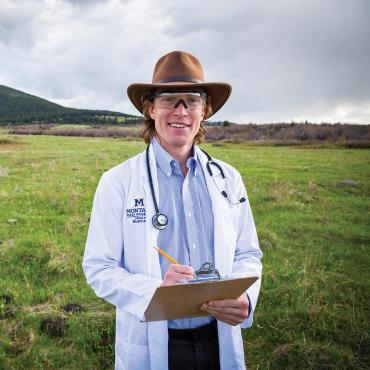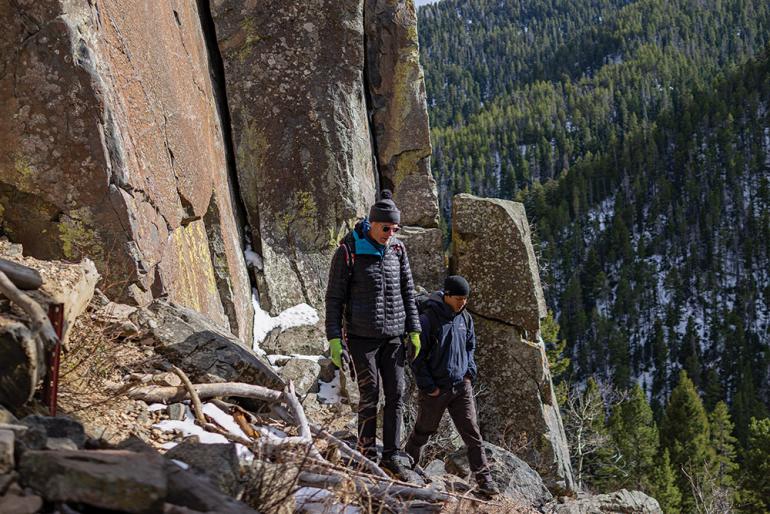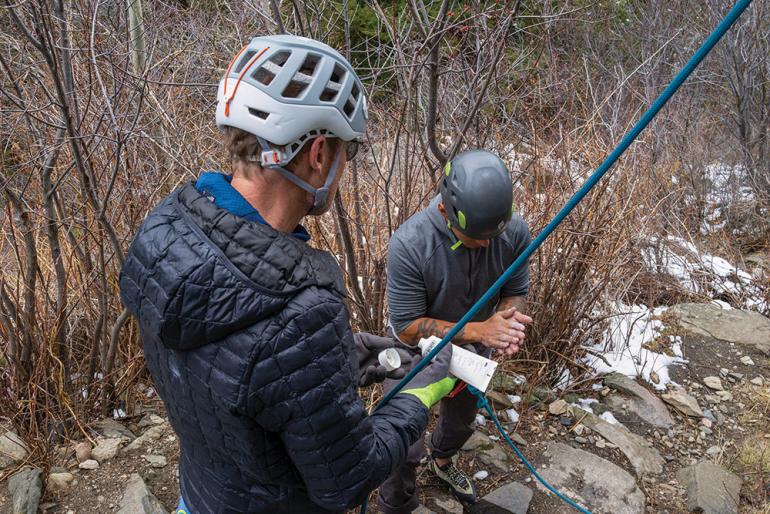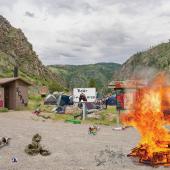Elevated Perspective
Sharing the rope with Conrad Anker.
Climbing in southwest Montana is special. With so many crags, and so few people, we frequently spend our time in solitude, sharing an entire cliff with a partner, not another soul in sight. We engage with the natural world—the smooth rock, whispering firs, and breathtaking views—devoid of distractions from other humans, an experience becoming increasingly rare as climbing gains popularity across the nation. We don’t suffer the weekend crowds that massive East Coast cities inflict on the Appalachians, nor the droves of worldwide travelers flocking to iconic destinations in Colorado, Utah, and California. We have a pristine resource at our disposal—but nonetheless, we are not immune to overusing our land.
Bozeman is growing, and along with it, the number of climbers. Each time we head out, we leave a trace of our presence. Footsteps erode soil and slopes become unstable. Chalk-covered hands tarnish rock and bolts degrade it. This is not to say that we should stop climbing, nor that we should stop using chalk or bolts. But as our impacts become more concentrated, we must set a precedent for preserving the land as much as possible. That is, after all, why we climb in the first place: to experience nature in a way that is reflective, meditative, and exhilarating, all at once.
To look at the current state of our impacts and reckon with the future trajectory of climbing in southwest Montana, I head to Practice Rock with Conrad Anker. The man needs no introduction—he’s been at the forefront of climbing’s progression for nigh on four decades. Originally hailing from the Sierra Nevada Mountains, he made Bozeman his home nearly 30 years ago, citing the expanse of wild, undiscovered climbing around southwest Montana as a factor that draws him in. “You go out there, hike up some drainage, and say, Oh, look at that, looks like a 5.10 hand crack. And you climb it, whether or not it’s been climbed before,” Conrad says. “You might find a vertebra of an animal somewhere on the trail, and place it in the crack as protection,” he continues, tongue-in-cheek, but I wouldn’t put it past him.
We walk up a trail of meticulously arranged talus steps alongside our friend Miles, a fishing guide out of West Yellowstone. Miles knows the environmental impacts of recreation better than anyone, having seen our cherished rivers disturbed by ever-increasing angling pressure. That’s another story in itself, but Miles is curious to see how climbers are addressing the issue. “With fishing, there are a lot of parties at play,” he says. “You have the guides and outfitters, the local recreational fishermen, and the Fish, Wildlife & Parks commission trying to find a solution that works for everyone. But there’s always a compromise—someone is always getting the short end of the stick.”
Though our climbing areas see only a fraction of the traffic that our rivers do, climbers face a similar dilemma. On top of the direct signs of increased usage, such as slope erosion, chalk marks, and bolts, our very efforts to curb environmental degradation can, paradoxically, leave a profound sign of human presence.
One of the biggest issues we face with increased traffic is erosion, given that the slopes surrounding our crags are generally quite steep. We disturb sensitive vegetation that helps keep the slopes stable, causing a snowball effect wherein as a slope is eroded, it becomes even more susceptible to further erosion. Tree roots lose their hold in the earth and seed banks are washed away by runoff, disrupting an ecological cycle that could take centuries to recover. To manage this, we build stable, reinforced trails, and we clear away scree to form level platforms from which to stage our climbs. But it’s a Catch-22: in an attempt to prevent runaway, irreversible environmental disturbance, we are rendering these places noticeably altered by the presence of humans. Can we find a middle ground? How can we mitigate environmental impacts while making our intervention as discreet as possible?
Conrad has some thoughts on the matter. As we flake our ropes, he notes, “Out here, except for our stuff, it’s all random. But if you make it rectilinear with straight wooden beams, which are sometimes treated with toxic resins, you’re just destroying the experience.” He’s referring to treated railroad ties, used as scaffolds for building platforms at the bottom of climbs. These aren’t in place at Practice Rock, but are widespread at other areas, including Allenspur and Bozeman Pass. If you’ve ever walked along a railroad track on a hot day, you know the smell of creosote—a tar distilled from organic materials such as coal, wood, and oil. Railroad ties are pressure-treated with creosote, which prevents them from rotting by killing off insects and fungi that would otherwise feed on the wood. This makes them a safe bet for reinforcing trails, but as the ties are weathered by rain and groundwater, runoff is contaminated with toxic compounds in the tar. Miles winces at the thought of it. How could we stand behind remediation that pollutes our water? Conrad is just as disturbed by the presence of man-made, unnatural-looking materials popping up across our outdoor climbing areas. Is there a better way?
It's a Catch-22: in an attempt to prevent runaway, irreversible environmental disturbance, we are rendering these places noticeably altered by the presence of humans. Can we find a middle ground? How can we mitigate environmental impacts while making our intervention as discreet as possible?
We don’t have to look far. As he clips a sparse selection of cams onto his harness, Conrad proposes an alternate solution. “We can use split wood instead, and we can even embed some rebar to support it.” He points out the surrounding deadfall as an efficient way to reinforce the ground more naturally. There would be no need to haul railroad ties up the trail, and it wouldn’t introduce toxic compounds into the environment. “Just around the corner, there are three or four blown-down trees. You could come up here with some splitting mauls and cut them to shape.”
Using natural materials might require more frequent maintenance—deadfall won’t last as long as treated wood—but it’s our responsibility to care for our crags, and organizations like Friends of Hyalite, the Southwest Montana Climbers Coalition, and the Custer-Gallatin National Forest are working hard to do it the right way.
Still, the very presence of climbers on otherwise untouched cliffs can spark controversy, and even someone as mindful as Conrad isn’t exempt from criticism. He recalls a pair of routes he established in Zion National Park. “They’d been photographed from a cool angle back in the ’60s and put into a book; the photo was a piece of art. After we bolted those in ’91 or ’92, holy shit, it was intense,” he says, referring to the backlash from conservationists. Indeed, Conrad recognizes the perpetual impact of establishing any climbing route, but also appreciates opening up new places for climbers to enjoy the outdoors—a familiar quandary for recreationists everywhere. His ethos for balancing access and impact is apparent in his preparation. He pulls out his signature liquid chalk—a solution of chalk mixed with ethanol—and gives Miles and me each a healthy dose to slather on our hands. When exposed to the air, the ethanol evaporates, leaving a residue that doesn’t smear onto the rock like powdered chalk. Conrad acknowledges that developing a crag will always impact its natural state, but reminds us that we are all obligated to tread lightly. “At the end of the day, it always takes a lot of work. But climbing on public land is a privilege to us as humanity, as living beings—considering that we treat with respect.”
Respecting the land means keeping it as pristine as possible. Conrad has had his fair share of climbing on untrodden ground, but he wants every climber to experience that visceral sense of discovery that is so unique to climbing in southwest Montana. As we tie into the rope—first Conrad, then Miles, then myself—Conrad speaks to climbing’s effect on the human psyche, accentuating the importance of preserving our outdoor climbing spaces. “Every human is different, and not everyone is going to have the same response. But recreation helps make us all better people, and helps us think more clearly, because it’s a very real pastime.” We step off the ground, and for that moment, leave the horizontal world behind, knowing that we’ll return with a reinforced appreciation for the inherent beauty of our surroundings—and, with any luck, a renewed commitment to keeping them that way.



















